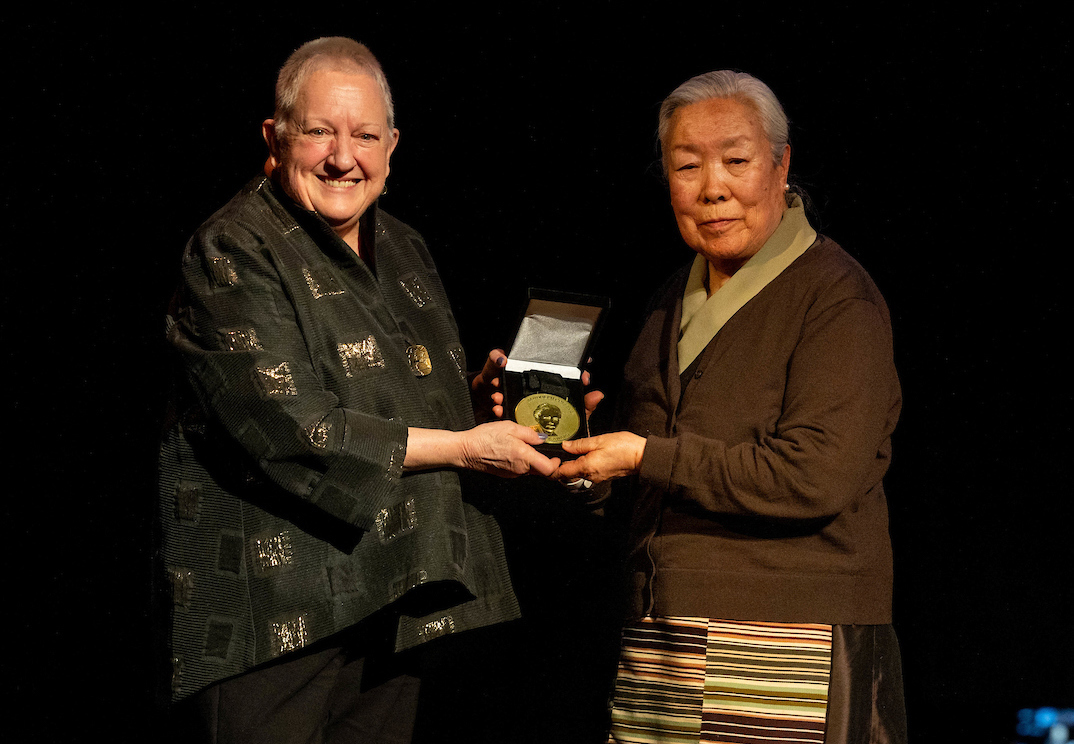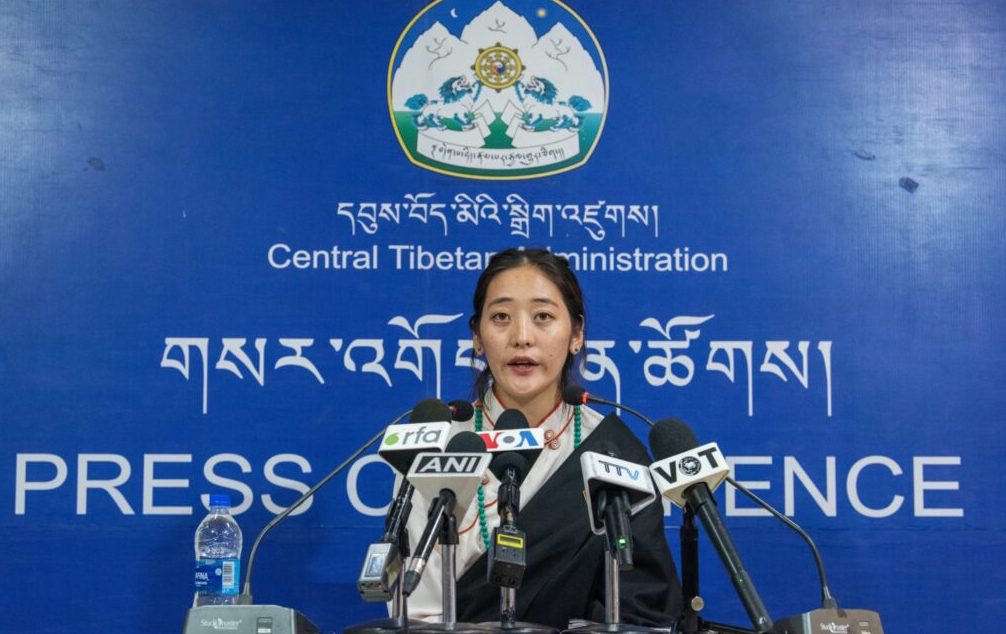By Karma T. Ngodup
Picture this: “For the estimated 3.2 billion viewers who get up early, stay up late, cheer at the television, bay at the moon, go out and beat drums in the middle of the night because somebody scored a goal halfway around the world, that’s the World Cup”. Soccer is truly the world’s game. It’s played in the heat of the Sahara, the jungles of the Amazon, the urban jungles of Calcutta and Los Angeles, and the manicured fields of Germany. There are some places so wild, though, that the idea of twenty-two players on a pitch seems impossible. One of those places is remote and austere Tibet, where people live at 4,500 meters altitude, in the shadow of Mount Everest and the rest of the Himalayas. Yet not only does Tibetan soccer have a toehold, it has a history.
Soccer penetrated Tibet as early as the first part of the twentieth century. A photograph taken by British military officer Frederick M. Bailey—who spoke the local language and was stationed in the Chumbi Valley with Colonel Francis Younghusband as part of the 1904 British Expedition to Tibet—shows Tibetans in the traditional chupa outfit, with long sleeves tugged around their waists, posing with a soccer ball. Yet it was not until the first English school was established in 1923 that the game of soccer reappeared in the hinterland of Tibet. Curiously, records indicate that four Tibetan boys journeyed to London in 1913, on the order of the thirteenth Dalai Lama, to be educated at the Rugby School in London, and reportedly played some rugby, but there is no indication that they brought rugby home with them.
Today, the game is known by many names: football for some, Fussball or futbol for others. In America and Canada, it’s soccer. Whatever we may call it, it is the ball that bears the brunt of the kick. The word spo lo (ball) is not new in the Tibetan vocabulary. As surprising as it may seem, the modern game of polo is said to have originated in Tibet in the 7th century, and the word is said to derive from the Tibetan word pulu, meaning ball. However, for the sake of expediency and to avoid confusing “the beautiful game” with American football, I will use the word soccer here.
Soccer began in Tibet in earnest with the English School in Gyantse in 1923, when Frank Ludlow (an Englishman), became the headmaster of the school. As Ludlow chronicles in his diary:
By the end of November, 30 boys had arrived, aged 8 to 18. Some of them were charming kiddies, well bred and well clothed. Others were not so prepossessing and evidently came of more plebeian stock. I got the boys to seat themselves at my rather primitive benches and had one or two cut down to suit their size. Everybody was so solemn whilst this was being done, and the boys looked so glum, that I fished out a couple of footballs and told all except 2 or 3 to go out and play in the compound. This worked wonders, and five minutes later when I went out I found them running all over the place, laughing and chattering in the very best of spirits…
Ludlow had been a member of his college football team at Cambridge. Ludlow’s enthusiasm for soccer even reached the ears of His Holiness the Dalai Lama, who asked about the result of a match between the school and an army team (the school lost 2-1), and then “enquired if it was true that I was very fond of ‘kicking the ball with my head!”
That the game of soccer persisted through the 1930s can be seen in British officer Frederick Spencer Chapman’s description of a match against Lhasa United in October 1936:
Today we were challenged to a game of “Soccer” by Lhasa United, a team consist of Nepali soldier, a Chinese tailor, three bearded Ladakis, a Sikkimese clerk of Pangda-Tsang, and five Tibetan officials including Yutok, Surkhang-Se, Taring, (other two maybe Ragashar and Shelling). They turned out in garish Harlequin-coloured silk shirts with L.U. sewn on to the pockets. After a good, clean, hard game the Mission Marmots (as we call ourselves) won by scoring the only goal of the day. Playing at 11,800 feet is not as much of an ordeal as one would imagine, and we appeared to be no more breathless than our opponents.
The game of soccer continued, with teams such as Lhasa United, Mission Marmot, and Drapchi, until 1944, when soccer was suddenly banned after a hailstorm during a game was taken as a bad omen. The monastic establishment induced the regent to issue a decree that declared that a kicking of football was “as bad as kicking the head of Buddha.” Such an act was not historically unprecedented: Even in a place such as Britain, where soccer is now a religion, King Edward II of England issued a proclamation in 1314 banning football because “there is great noise in the city caused by hustling over large balls from which many evils may arise which God forbid.” Centuries later, the word “football” was used disapprovingly by Shakespeare in King Lear: “Nor tripped neither, you base football player.”
By the end of the Second World War, soccer was poised for a Tibetan explosion. Popular clubs emerged, such as the Lhasa, the Potala, the Drapchi, and the Bodyguard Regiment soccer teams. There were as many as fourteen squads, though no formal Tibetan League had yet been established.
Following the Tibetan National Uprising on March 10, 1959, football survived through the cracks of supposedly modernization as Drikung Chetsang Rinpoche discusses in his biography. Rinpoche himself was known for his amazing soccer skills, as signified by the saying that he had “a golden foot.”
From childhood and beyond, Rinpoche has a great passion for soccer. And what more nostalgic gift could there be to celebrate his birthday than with a soccer tourney?
Every year, with the regularity of a Facebook birthday reminder, young boys in Dekyiling hang their soccer cleats on their shoulders and await the call to the pitch. Not far from there, one of the most prominent soccer clubs in exile at Clementown organizes a memorial tournament for Paltrul Rinpoche.
First, let me take you back to the time when the first Tibetan school was opened in 1960 in Mussoorie, India, soccer became the exiled students’ favorite pastime. Since many of these students had left Tibet with little more than the clothes on their backs, they were reduced to playing barefoot with balls fashioned from rags and socks. Their time on the pitch was a way to forget, at least temporarily, their arduous journeys and tragic histories. Such was their devotion to the game that, in 1968, they won the inter-school championship among some of the best international and private schools in India.
Here it may suffice to describe how much inspiration this triumph was for a young soccer player such as myself; the story propelled my teammates and me toward victory in our first sub-Junior soccer cup. Stories of that team are ever-present in my old school, where photographs of the team still hang in the corridors. One can imagine the same kinds of stories and other photos in countless other schools.
So when the great mother of H.H. the Dalai Lama passed away in 1981, Tibetans in Dharamsala inaugurated the Gyalyum Chenmo Memorial Gold Cup (GCMGC) Soccer Tournament in her memory, with an iconic trophy made from gold and silver and studded with semi-precious stones. The Tibetan people wanted to express their love and respect for the Great Mother and to remember her kindness, and there was no better way than through the game so many Tibetans love so passionately. The first GCMGC tournament took place at the Tibetan Children’s Village grounds in October of 1981. The first cup was designed at the Norbulingka Institute, with stones from the private office of H.H. the Dalai Lama.
Tibetan soccer continued to thrive locally in the decades to come, but a major leap forward was made in 1998. That year, in response to an invitation from the Italian rock music group Dinamorock, a Tibetan national team was formed to compete in Bologna, Italy, the next year, an effort in which Kasur Jetsun Pema played an instrumental role. This was a turning point for Tibetan soccer, as so many talented players had nurtured quiet dreams of playing for a Tibetan National Team. Around this same time, the Danish trekker Michael Nybrant conceived of a Tibetan National Team tour, and went on to play a pivotal role in arranging the national team’s successful and historic series of matches in Denmark, Germany, and Switzerland, in 2001.
Prior to the European tour, the squad had an audience with H.H. the Dalai Lama in which he expressed curiosity as to whether the national teams of India, Nepal, and Bhutan had similar opportunities to play abroad. At the time, I immediately felt his signature-style of spontaneity, reminding our players of how fortunate they were to travel to and play in countries where soccer is not merely a game, but a way of life.
With those visits to Europe, the doors of the soccer world finally opened for Tibet. Soon thereafter, the Tibetan National Team toured France in 2003, and even made contact with representatives from FIFA. That encounter ultimately led to FIFA awarding Tibet its first-ever FIFA ranking (175)—a ranking that lasted for just two days in 2004, removed after numerous complaints from the China’s sports authority. FIFA later claimed in a letter that the decision was based on Tibet “not fulfilling the requirement” to be its member. However, all the international recognition led to further positive movement in 2006, during the World Cup. Barred from qualifying for the FIFA World Cup by China’s unwillingness to have Tibet field its own squad, the Tibetan National Team traveled to Germany to participate in the parallel international competition known as the FIFI Wild Cup. That event, administered by the Federation of International Football Independents (FIFI), featured teams from nations not yet recognized by FIFA as well as FIFA member teams from the Asian Football Confederation. In 2008, the national team toured Europe again, playing eight international matches.
Back in India once again, people from Kadorgangsum (refers to the regions of Kalimpong, Darjeeling, and Gangtok) flocked into the Paljor Stadium, forming a massive crowd of young and old, men and women, lay and monk. This time it wasn’t Kalachakra, the cycles of time, but rather soccer, the cycles of kicks. The Tibetan National team was laboring to get through the Sikkim Governor’s Cup, a hugely popular soccer tournament in India drawing the best of the best soccer clubs in India, including the squad from Bhutan. For the Tibetan players and supporters, it was an emotional time—a chance to connect with others whose cultural ties with Tibet cannot be overlooked. Though Tibet lost its last match against Bhutan, the team has gone on to play more soccer in Europe.
The years have gone by and, with them, a new generation of young Tibetan girls are taking their place in the sport. The young women are playing with all the intensity of the men, engaging in numerous matches against school teams, and even squads from various states in India. One women’s team has already made a maiden trip to Germany, and there are hopes that the Tibetan women’s team will come to the United States in the near future. With the United States winning its third Women’s World Cup last year, The Forbes Sports front-page title captures, “Girls soccer on the rise due to USA World Cup Victory.” That victory has already inspired a generation of young girls to aim to become the next Carli Lloyd or Alex Morgan. The day will assuredly come when Tibetan women will have their own successes in competitive soccer.
Another round of the GCMGC India has recently been completed at Mundgod. To the great credit of the national and regional broadcasters, all the games were live streamed efficiently and shared on social media. Considering the paucity of coverage in the early days of the tournament, this represents great progress.
That inspiration can be drawn from such events that will fuel a future soccer boom in the Tibetan diaspora can be seen in this wonderful photograph of young fan captured during last year’s GCMGC at Dharamsala. Probably, these fans explain best the young monk Ogyen’s obsession with soccer in movie “The Cup” as one review states thus: “beneath his maroon monastic robes, sports a tank top on which he has emblazoned the name and number of Ronaldo, the Brazilian star.
The best is certainly yet to come. The first GCMGC North America is to be played in Toronto, Canada, during the July celebration of H.H. the Dalai Lama’s birthday. We are hopeful that someday soon, based on auspicious events like this, Tibetan players will be tapped to participate in Major League Soccer (MLS) in North America, or even in the British Premier League or Bundesliga. And let’s dream and hope that one day, when half the world gets up early and beats the drums of victory across the globe, it will be in celebration of a Tibetan goal.
The Author is a coordinator of Tibetan National Sports Association in North America.
Reference and Notes:
• British Library Collections: Bailey, Frederick Marshman. Tibetan football team, Chumbi. Photo 1083/17(206) 27 Jan 1907
• Vecsey, George. “Sports of The Times; Six Months to Obsess About World Cup Schedule.” The New York Times. The New York Times, 06 Dec. 1997.
• “Tibetan National Sports Association.” Tibetan National Sports Association. Tibetan Children’s Village, 10 Mar. 2003. Web. 28 Apr. 2016.
• Frank Kingdon-Ward by Charles Lyte (London, 1989), p. 70, Lord Cawdor’s diary quotes “I played for the Tibetan team.”
• “King Arthur Comes To Tibet: Frank Ludlow and the English School in Gyantse, 1923-26.” Academia.edu.
• Ludlow diary (1923-1946) British Library, Oriental and India Office Collection (OIOC), Mss 979
• Freeman, C. (2006) The Tibetan Album: British Photography in Central Tibet 1920–1950.
• Modern polo is derived from the Tibetan game. rta pu lu (horse ball) played in Tibet as early as in the 7th century.
• “Tibetan Pulu”, originally appearing in Volume V22, Page 12 of the 1911 Encyclopedia Britannica.
• From the Heart of Tibet: The Biography of Drikung Chetsang Rinpoche, the Holder of the Drikung Kagyu Lineage, August 10, 2010
• Pitt Rivers Museum, Harris, C., Tsering Shakya,. Seeing Lhasa: British Depictions of the Tibetan Capital, 1936-1947. Chicago: Serindia, 2003. Print.
• Shakespeare, William, and Horace Howard Furness. King Lear. Philadelphia: J.B. Lippincott & Co., 1880.
• Cashmore, Ernest Ellis. Making Sense of Sports. Milton Park, Abingdon, Oxon: Routledge, 2010. Print.
• McKay, A. “‘Kicking the Buddha’s Head’: India, Tibet and footballing colonialism.” Soccer and Society 2, no. 2 (2001): 89-104.





































